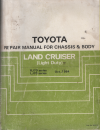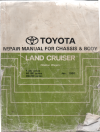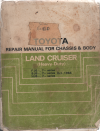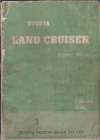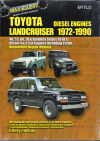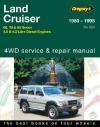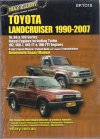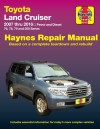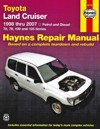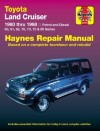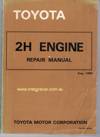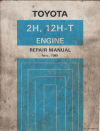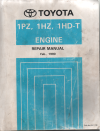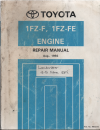Login to enhance your online experience. Login or Create an Account
Diesel Landcruiser
|
|
Diesel Landcruiser
Default | Name Up | Name Down | Price Up | Price Down
The Toyota Land Cruiser is a few four-wheel drive cars made by the Japanese automobile maker Toyota. It's Toyota's longest running show.
Production of 1st generation Land Cruiser started in 1951 (90 devices) as Toyota's version of a Jeep-like car. The Land Cruiser has been stated in convertible, hardtop, place truck, and energy truck versions. The Land Cruiser's dependability and durability features resulted in big popularity, especially in Australia where this is the best-selling body-on-frame, four-wheel drive car. Toyota in addition extensively tests the Land Cruiser in Australian outback --- considered to be among most challenging running conditions in both temperature and surface. Main rivals through the number Rover, land-rover breakthrough, Jeep Wrangler, Mitsubishi Pajero and Nissan Patrol. In Japan, the Land Cruiser is unique to Toyota Japanese dealerships known as Toyota shop.
In 1936, Toyota registered the traveler vehicles market along with its design AA and held a competition to establish a brand new logo design emphasizing speeds for its new manufacturer product line. After obtaining 27,000 entries, one had been picked that additionally triggered a change of their moniker to "Toyota" from families title "Toyoda". The latest name was believed to sound better, and its eight-stroke count within the Japanese language had been involving wealth and chance. The original logo not any longer is found on its automobiles, but remains the business emblem found in Japan.
However, no instructions existed for the use of the brand name, therefore "TOYOTA", that was put throughout a lot of the world, led to inconsistencies with its globally advertisements campaigns.
To remedy this, Toyota introduced a fresh globally logo design in October 1989 to commemorate the 50th seasons associated with team, also to differentiate it through the newly circulated luxury Lexus brand. The logo design made their first on 1989 Toyota Celsior and rapidly gained globally recognition. The 3 ovals in newer logo design combine to make the page "T", which represents Toyota. The overlapping for the two perpendicular ovals in the bigger egg-shaped portray the mutually beneficial commitment and trust between the buyer and organization, even though the larger oval surrounding both these inner ovals signifies the "global expansion of Toyota's tech and unlimited possibility of the near future."
Hubcap of 1936 Toyota AA, with all the old "Toyoda" title
The brand new logo begun appearing on all printed material, advertisements, supplier signage, together with motors on their own in 1990.
950 --- The Korean War produced interest in an army light utility vehicle. The war placed a Jeep on Japan's home. The United States authorities bought 100 motors using the latest Willys specs and Toyota ended up being requested to create them.
1951 --- The Toyota "Jeep" BJ prototype originated in January 1951. This came from the interest in military-type utility cars, much like the British Land Rover show 1 that starred in 1948. The Jeep BJ ended up being larger than the first U.S. Jeep and much more powerful thanks to their means B 3.4 L six-cylinder OHV Gasoline motor which created 63 kW (86 PS; 84 hp) at 3600 rpm and 215 N*m (159 lb*ft) torque at 1600 rpm. They have a part-time four-wheel drive program like Jeep. Unlike the Jeep, but the Jeep BJ had no low-range transfer case.
1951 --- In July 1951, Toyota's test motorist Ichiro Taira drove the new generation of Jeep BJ prototype as much as the 6th phase of Mount Fuji, the first car to rise that high. The test ended up being overseen by the nationwide authorities agencies (NPA). Impressed by this task, the NPA quickly placed an order for 289 among these offroad motors, creating the Jeep BJ their official patrol vehicle.
1953 --- Regular creation of the "Toyota Jeep BJ" started at Toyota Honsya Plant (Rolling chassis construction), and the body construction and painting is finished at Arakawa Bankin Kogyo KK, later on called ARACO (today an affiliate of Toyota Auto human anatomy Co.). The "Toyota Jeep BJ" show had been launched alongside the annotated following:
BJ-T (Touring),
BJ-R (Broadcast),
BJ-J (Cowl-chassis for a fire-engine).
1954 --- The name "Land Cruiser" is made because of the technical manager Hanji Umehara. "In The united kingdomt we had another rival --- Land Rover. I'd to create a name for our car that would not appear less dignified compared to those of our rivals. That's the reason I made a decision to call it 'Land Cruiser'," he recalls. The name have been already utilized on the usa Studebaker Land Cruiser automobile from 1934 to 1954 but this don't trigger any dilemmas.
1954 --- The 93 kW (126 PS; 125 hp), 3.9 L Type F gas system included when it comes to fire-engine framework. Models are renamed since:
BJ-T (Touring),
BJ-R (Broadcast),
BJ-J (Cowl-chassis for a fire-engine),
FJ-J (Cowl-chassis for a fire-engine).
Diesel fatigue try created inside diesel motors, where circumstances differ significantly from spark-ignition engines. Diesel system energy are directly managed by the gasoline offer, perhaps not by controlling the atmosphere offer such as mainstream fuel machines. Once the motor runs at idle, enough air occurs to burn the gas entirely. Diesel motors best make significant amounts of smoke when running without adequate air. It's usually mitigated in a turbocharged diesel engine.
Diesel exhaust is renowned for their characteristic smell, but it has mainly disappeared recently after reductions in sulfur information.
Diesel exhaust is believed to consist of harmful environment pollutants and is indexed as carcinogen for humans by the IARC in-group 1. Diesel fuel also contains fine particles associated with bad fitness issues. Diesel exhaust air pollution is thought to take into account around one quarter of this air pollution floating around in previous decades, and a higher share of nausea caused by automotive pollution.
The lean-burning nature of diesel engines additionally the high conditions and pressures of this combustion techniques end in considerable production of nitrogen oxides, and a unique challenge in reducing these substances. Contemporary on-road diesel engines typically use discerning catalytic decrease to meet up with emissions regulations, as more means particularly exhaust fuel recirculation cannot adequately decrease NOx to meet up with new guidelines in several jurisdictions. However, the fine particulate question (often visible as opaque dark-colored smoke) features traditionally already been of greater concern into the world of diesel exhaust, as it presents different health problems and is rarely stated in big amounts by spark-ignition motors.
Diesel machines build little carbon monoxide while they burn off the gas in excess environment also at full-load, where aim the number of fuel injected per pattern remains about 50 percentage lean of stoichiometric.
Diesel particulate point (DPM), occasionally also referred to as diesel exhaust particles (DEP), is the particulate component of diesel exhaust, which include diesel soot and aerosols such as ash particulates, metallic abrasion particles, sulfates, and silicates. Whenever revealed in to the surroundings, DPM usually takes the type of individual particles or string aggregates, with most in hidden sub-micrometre range of 100 nanometers, also referred to as ultrafine particles (UFP) or PM0.1.
The main particulate fraction of diesel fatigue is made from fine particles. For their small-size, inhaled particles may effortlessly penetrate deep to the lung area. The rough surfaces among these particles makes it easy for them to bind along with other toxins inside environment, thus increasing the risks of particle breathing.
As soon as the motorist releases the accelerator on a moving automobile run on a diesel system, the vehicle's forward energy will continue to switch the engine's crankshaft. Diesel machines, by design, do not have throttle butterfly in the consumption so aside from throttle position a full cost of air is obviously drawn to the cylinder. (Early Mercedes diesels being a notable exception.) As such, every time environment are squeezed in a cylinder virtually 100per cent of that energy is returned to the crankshaft providing hardly any when it comes to engine stopping to your car.
The standard compression release engine braking system, because initially developed, uses an add-on Hydraulic system utilizing system oils. When triggered the movement of this gasoline injector rocker supply is transferred to the system exhaust valve(s). This takes place most near TDC and releases the compressed air in the cylinder so that that energy is maybe not returned to the crankshaft. Energy is today absorbed and motor becomes a great "brake." If used correctly this power may be used because of the truck motorist to keep rate and on occasion even slow the automobile with little to no or no utilization of the solution brake system.
Comparison a gas engine, in which the mechanics will vary and a unique device just isn't needed for system braking to happen when the motorist releases the accelerator. In a gas motor, when the accelerator circulated, the throttle stops the free airflow in to the cylinders, so there are small force to discharge towards the top of the compression swing. The closed throttle provides motor braking by forcing the engine to build vacuum pressure amongst the throttle and the cylinders.
Diesel compression release brake settings consist of an on/off change and, usually, a multi-position turn that manages the sheer number of cylinders where the brake was energetic. Throttle and clutch switches become key because of the system. Activation takes place when both the clutch are revealed with transmission in equipment and also the throttle is revealed. It will be the motorist's work to see the right transmission gear to utilize according to, like, the steepness regarding the class and if the truck is loaded or empty.
The name is derived from the producer, Jacobs (of drill chuck fame), and had been patented 1962--1965 by Clessie Cummins.
The Toyota J40 is the design designation for a Toyota Land Cruiser 40 show created from 1960 until 1984 (in Brazil, where it had been known as the Toyota Bandeirante, it had been made from 1968 until 2001). Most 40 show Land Cruisers had been built as two-door vehicles with a little bigger measurements than a Jeep CJ.
The design ended up being offered since the FJ40 show (with F machines) and also BJ40/41/42 (quick wheelbase), BJ43/44/46 (middle wheelbase) or HJ45/47 (lengthy wheelbase) designation in which it had a Diesel motor. Land Cruisers integrated Brazil from 1968 to 1993 - with Mercedes-Benz machines - obtained OJ40/45 (OJ50/55 from 1973) series framework rules and those built from 1994 to 2001 - with Toyota motors - has BJ50/55 series model rules.
Sources to your show in this specific article is to the J40 series unless discussing the petrol (FJ40/42 -- 2WD) or diesel (BJ4#/HJ4#) designs especially.
The J40/41/42 is a two-door brief wheelbase four-wheel-drive car, with either a soft or a hardtop (V). It absolutely was readily available with different petrol or diesel (from 1974) motors over its lifetime. It was changed on most areas from 1984 because of the J70 show (70/71).
The FJ42 try 4X2 design, for only The Middle East.
The J43/J44/46 ended up being an exceptionally rare two-door medium wheelbase four-wheel-drive vehicle, with either a smooth or a hard-top (V). It was replaced of all areas from 1984 by the J70 show (73/74).
The J45/47 had been a long-wheelbase four-wheel-drive automobile, available in two-door hardtop, three-door hardtop, four-door place truck and two-door pickup brands. The four-door place wagon design (FJ45V-I) ended up being the shortest-lived regarding the J40 series, since it was changed because of the FJ55G/V in 1967.
The Bandeirante TB25/TB41/TB51 Series are J25 series Land Cruisers integrated Brazil by Toyota do Brasil Ltda from 1962 to 1968. In 1966 these people were changed because of the OJ32 (soft top) and OJ31 (hard top) for the TB25, and also the TB81 for TB51; for an unknown explanation the TB41 would keep their J2 signal until 1968 when Toyota manage Brasil switched toward J40 series.
The second generation Bandeirante OJ40/OJ45 Series (1968 to 1973), OJ50/OJ55 Series (1973 to 1994) and BJ50/BJ55 show (1994 to 2001) tend to be J40 series automobiles integrated Brazil by Toyota manage Brasil Ltda from 1968 to 2001. Identical to the BJ40 in virtually every respect, it have several stylistic improvements towards grille (systems produced from 1989 on featured square headlights, rather than the circular ones made use of before) and put Mercedes-Benz OM-314/OM-324/OM-364 diesel engines (replaced by Toyota 14B inline 4 direct injection Diesel motor in 1994) for much of its manufacturing lifetime; another visible gran characteristic will be the entire hind doors (like at Land Rover) rather than the traditional Toyota two-wing hind doors during the Bandeirante's hard top brands.
Indirect shot in an interior combustion motor was gasoline injections where gas just isn't straight injected to the combustion chamber. Gasoline machines usually are designed with indirect shot techniques, wherein a fuel injector delivers the gasoline eventually prior to the consumption valve.
An indirect injection diesel motor brings gasoline into a chamber from the combustion chamber, labeled as a prechamber, where burning starts and spreads to the primary combustion chamber. The prechamber try very carefully made to secure sufficient blending of this atomized fuel because of the compression-heated air.
The purpose of the split combustion chamber is to accelerate the combustion processes, being raise the energy production by increasing engine rate. The choice of a prechamber, however, increases temperature reduction to your cooling system and therefore lowers system efficiency. The motor need glow plugs for beginning. In an indirect injection program air moves quickly, combining the gas and environment. This simplifies injector build and enables making use of smaller engines much less securely toleranced styles that are much easier to produce and more reliable. Direct injections, by contrast, utilizes slow-moving atmosphere and fast-moving gasoline; both the design and make of this injectors is much more tough. The optimisation for the in-cylinder venting is a lot more harder than designing a prechamber. There's much more integration amongst the build associated with injector additionally the motor. It is because of this that automobile diesel motors are the majority of indirect shot before prepared availability of effective CFD simulation techniques made the adoption of direct injections useful.
1984 --- 70 Series was launched as a soft-top, hard-top, FRP top, energy, cab-chassis, and Troop provider (inwards facing back chairs).The petrol system had been changed with a 4.0 L 3F motor. The 70 Light have a four-wheel coil spring solid-axle suspension for much better ride high quality. This lighter responsibility type of the Land Cruiser had the 22R 2.4 L fuel engine, 2L and 2L-T (turbo) 2.4 L diesel machines commonly found in the Toyota Hilux. The 70 Light had been sold in some markets due to the fact Bundera or even the Landcruiser II, later labeled as 70 Prado. The 70 Prado fundamentally became popular and evolved into the 90. An automatic transmission (A440F) was introduced making it the very first four-wheel drive Japanese vehicle with an automatic transmission.
1990 --- New-generation diesel engines are introduced like a 3.4 L five-cylinder SOHC normally aspirated motor (1PZ),and a 4.2 L six-cylinder SOHC obviously aspirated engine (1 HZ).
1993 to 1996 --- the KZ 3.0 L turbocharged diesel engine replaced the LJ within the 70 show in European areas in which this design had been referred to as KZJ70.
1993 --- an enhanced 24-valve, 4.5 L six-cylinder petrol system, 1FZ-FE was introduced.
1999 --- Toyota up-to-date the 70 series in lot of ways. The solid front side axle got coil-spring suspension system. The trunk leaf springs were lengthened for increased trip benefits and wheel vacation. The six-bolt rims were replaced with five-bolt wheels. Several modest changes on drivetrain provided enhanced durability. The long-wheel-base brands gotten brand-new designations: 78 for troop company, and 79 for pick-up.
2002 --- HDJ79 try introduced to Australia utilizing the 1HD-FTE 4.2 L six-cylinder 24-valve turbodiesel EFI motor.
2007 --- Toyota's very first turbodiesel V8 motor, the 1VD-FTV premiered in some nations for 70 Series Land Cruiser. Other improvements are the connection of a 4-door medium-wheel-base model (the 76) and an altered forward search on all brands.
2012 -- choice associated with the 79 dual taxi pickup, in Southern Africa (4.2 L Diesel or 4.0 L Petrol) and Australian Continent (4.5 L V8 Diesel).
The Sixth and Seventh years of this Land Cruiser will always be being produced and sold in African and Latin-American regions. Manufacturing in Venezuela ended in 2008.
The 70 show normally however advertised in Australian Continent as 4-door wagon, 2-door 'Troop Carrier', 2 home cab-chassis and 4 door cab-chassis.
The Land Cruiser 80 series had been unveiled in October 1989 on Tokyo engine Show and launched during the early 1990. They had swing-out back doorways, that have been replaced by a winch door in 1994. The Land Cruiser is nicknamed the Burbuja (Bubble) in Colombia and Venezuela due to its roundness, but it is formally introduced as Land Cruiser Autana both in countries. Title was a reference into Tepui mesa Autana, a spectacular plateau and cave system across the Guiana Shield craton. Land Cruiser business achieved 2 million cars.
1990 --- The 80 show facility wagon ended up being launched, changing the 60 show. All 80s sold in the united states and Europe currently have a full-time four-wheel drive system. In Japan, Africa, and Australia, a part-time program had been nonetheless offered. 80s created between 1990 and 1991 have an open centre differential that has been lockable in 4HI and immediately closed in 4LO. From 1992 onward, automobiles with anti-lock brakes had a viscous coupling that sent at the most 30% torque on non-slipping axle. The differential had been lockable in 4HI and instantly locked in 4LO.
1990 --- A unique generation of diesel machines were introduced, adding to the motors available in the 80 show. The 80 show came with either a (3F-E) six-cylinder obviously aspirated petrol motor, a six-cylinder SOHC normally aspirated diesel system, (1HZ), or a 1HD-T direct shot turbo diesel.
1991 --- By mid-1991 the (3F-E) had been launched into the Australian markets, a fuel inserted form of the 3F.
1993 --- a sophisticated 24-valve, 4.5 L six-cylinder petrol system, 1FZ-FE is launched. Larger brake system had been included from October 1992 and total wheelbase had been made slightly much longer. Forward and back axle lockers (code k294) made an appearance as an option. The High Pinion Electric Locking front differential be for sale in US brands. In May 1993 Toyota started using R134 refrigerant in the air fitness program. Serial data less than JT3DJ81xxxxx38947 use R12 refrigerant.
1994 --- A limited edition Land Cruiser Blue Marlin (FZJ80R) had been introduced in to the Australian marketplace. They've 4.5 L right 6 petrol motors with double-overhead cameras, automated or manual transmission and 158 kW (215 PS; 212 hp) at 4600 rpm. The vehicle is blue through the Blue Marlin seafood and they have the azure Marlin logo design for the car. A number of the functions your azure Marlin included were altimeters, power windows, disk brake system, leather equipment knob and controls, main locking, leather trim, chrome manages and sidesteps, 16" alloy rims, limited-slip differential, anti-lock brakes (ABS), energy steering, CD and cassette people, flares, and a finite version bull bar. Just 500 were made.
1995 --- Driver and traveler airbags are introduced as had been flexible shoulder-belt anchors and an anti-lock braking system. The "T O Y O T A" badge was replaced because of the modern Toyota logo (that will be sometimes described as a "bean with a hat" aka "the sombrero").
1996 --- into the Dakar Rally, a set of Land Cruisers complete first and 2nd in unmodified manufacturing course. All American and Uk eighties followed anti-lock brake system and airbags as standard equipment. The Land Cruiser ended up being withdrawn from Canada this season and had been changed by the Lexus LX 450.
1997 --- a small run of Land Cruiser 80s ended up being built especially for collectors therefore known as the Land Cruiser Collector's version. The enthusiasts Edition sported enthusiasts version badging, "Collector's Edition" embroidered flooring mats, automatic weather control, tires because of the "D" microsoft windows coated dark grey and special grey part moldings, and black colored pearl badging. The Collectors Edition was only designed for the 1997 model 12 months plus the bundle had been included with many of the offered human body colors.
1997 --- 4744 FZJ80 Land Cruisers had been offered in the us as "40th Anniversary Limited Edition" products. These were available in 2 tones; Antique Sage Pearl (often referred to as Riverrock, Pewter, or gray) and Emerald Green. The 40th Anniversary brands included apron badges, a serial quantity badge regarding the center console, black pearl outside badges, "40th Anniversary Limited version" embroidered floors mats, automated climate control, two-tone tan and brown leather interiors, and tires using the "D" microsoft windows coated dark-gray. Numerous had been made with all the recommended electric front side and rear locking differentials, keyless entry, port-installed roofing racks, and run panels. There are numerous examples that didn't have several extras. This is basically the last year when it comes to electric securing front differentials.
2008 --- final 80-Series car was built-in Venezuela which was the sole country creating the motors after production finished in Japan in 1997.
Typical train direct gas injection was a contemporary variant of direct fuel injections program for petrol and diesel engines.
On diesel machines, it features a high-pressure (over 1,000 club or 100 MPa or 15,000 psi) gasoline train feeding specific solenoid valves, in the place of low-pressure gas pump feeding product injectors (or pump nozzles). Third-generation typical train diesels today function piezoelectric injectors for increased accuracy, with fuel pressures to 3,000 club (300 MPa; 44,000 psi).
In gas engines, it is used in gas direct injection system technologies.
Solenoid or piezoelectric valves render possible fine electric control of the fuel injection time and volume, together with greater pressure that typical train technologies makes available provides best fuel atomisation. To lessen system sound, the system's digital control unit can inject handful of diesel prior to the primary shot occasion ("pilot" injection), thus reducing their explosiveness and vibration, along with optimising injection time and volume for variations in fuel quality, cool starting etc. Some advanced typical rail gasoline techniques perform up to five shots per swing.
Popular train engines require a really short (< 10 moments) to no heating-up time, according to ambient temperatures, and create reduced engine sound and emissions than older systems.
Diesel engines need typically used different types of gasoline injections. Two typical kinds range from the device injection program plus the distributor/inline pump methods (read diesel motor and unit injector to find out more). While these older techniques offered precise gasoline amount and injection timing control, they certainly were tied to a number of issue:
These people were cam driven, and shot pressure was proportional to engine rate. This usually implied your greatest shot stress could simply be obtained in the greatest engine speeds together with optimum achievable injection stress reduced as motor speed decreased. This partnership holds true with pumps, even those used on common train methods. With product or distributor systems, the shot force was linked with the instantaneous stress of an individual pumping occasion without accumulator, and so the partnership is more prominent and problematic.
They were restricted when you look at the number and timing of shot activities that could be commanded during an individual combustion event. While several injections events tend to be possible with one of these elderly systems, it really is a great deal more harder and pricey to realize.
When it comes to typical distributor/inline system, the start of injection taken place at a pre-determined stress (often referred to as: pop music stress) and finished at a pre-determined force. This characteristic lead from "dummy" injectors in the cylinder head which established and closed at pressures determined by the springtime preload placed on the plunger inside injector. When the force when you look at the injector achieved a pre-determined degree, the plunger would lift and shot would start.
In keeping train systems, a high-pressure pump stores a reservoir of gasoline at ruthless --- as much as and above 2,000 taverns (200 MPa; 29,000 psi). The term "common railway" is the undeniable fact that all gas injectors are furnished by a typical fuel rail that will be nothing more than a pressure accumulator where gas is stored at high pressure. This accumulator supplies several gasoline injectors with high-pressure gasoline. This simplifies the goal of the high-pressure pump in that it only needs to preserve a commanded pressure at a target (either mechanically or digitally influenced). The gasoline injectors are typically ECU-controlled. As soon as the gas injectors were electrically triggered, a hydraulic device (composed of a nozzle and plunger) was mechanically or hydraulically started and gasoline is dispersed into the cylinders at the desired pressure. Since the gas force energy sources are saved remotely plus the injectors tend to be electrically actuated, the shot force in the beginning and end of injections is extremely close to the force when you look at the accumulator (railway), hence making a square injections rates. In the event that accumulator, pump and plumbing are size properly, the injections force and rate would be the exact same for each regarding the numerous injections events.
Product injector (UI) was an integrated direct gas injections system for diesel machines, incorporating the injector nozzle plus the injections pump in one component. The plunger pump utilized is generally driven by a shared camshaft. In a unit injector, these devices is usually lubricated and cooled because of the gas it self.
The fundamental operation can be described as a sequence of four separate stages: the completing phase, the spill state, the injections stage, additionally the stress decrease phase.
A low stress gas shipments pump provides blocked diesel gasoline into the cylinder mind gasoline ducts, and into each injector gas interface of constant stroke pump plunger injector, that is overhead camshaft run.
Fill period
The continual swing pump element on the way up draws gas through the offer duct in to the chamber, and as long as electric solenoid valve remains de-energized gasoline range are open.
Spill stage
The pump factor are on your way straight down, so when longer as solenoid valve stays de-energized the fuel line are available and gas flows in through in to the return duct.
Shot state
The pump factor is still on the road down, the solenoid is now stimulated and fuel range is currently shut. The gasoline can't pass back in return duct, and it is today compressed because of the plunger until force surpasses specific "opening" pressure, and the injector nozzle needle lifts, enabling gasoline to be injected into the combustion chamber.
Force decrease stage
The plunger continues to be on its way down, the system ECU de-energizes the solenoid whenever required volume of gasoline are delivered, the fuel device opens up, fuel can stream back in return duct, causing force fall, which often trigger the injector nozzle needle to closed, therefore no further gasoline are injected.
Overview
The beginning of an injection try monitored by the solenoid closing aim, and injected fuel amount is determined by the closing time, which is the period of time the solenoid keeps sealed. The solenoid process is fully monitored by the engine ECU.
Production of 1st generation Land Cruiser started in 1951 (90 devices) as Toyota's version of a Jeep-like car. The Land Cruiser has been stated in convertible, hardtop, place truck, and energy truck versions. The Land Cruiser's dependability and durability features resulted in big popularity, especially in Australia where this is the best-selling body-on-frame, four-wheel drive car. Toyota in addition extensively tests the Land Cruiser in Australian outback --- considered to be among most challenging running conditions in both temperature and surface. Main rivals through the number Rover, land-rover breakthrough, Jeep Wrangler, Mitsubishi Pajero and Nissan Patrol. In Japan, the Land Cruiser is unique to Toyota Japanese dealerships known as Toyota shop.
In 1936, Toyota registered the traveler vehicles market along with its design AA and held a competition to establish a brand new logo design emphasizing speeds for its new manufacturer product line. After obtaining 27,000 entries, one had been picked that additionally triggered a change of their moniker to "Toyota" from families title "Toyoda". The latest name was believed to sound better, and its eight-stroke count within the Japanese language had been involving wealth and chance. The original logo not any longer is found on its automobiles, but remains the business emblem found in Japan.
However, no instructions existed for the use of the brand name, therefore "TOYOTA", that was put throughout a lot of the world, led to inconsistencies with its globally advertisements campaigns.
To remedy this, Toyota introduced a fresh globally logo design in October 1989 to commemorate the 50th seasons associated with team, also to differentiate it through the newly circulated luxury Lexus brand. The logo design made their first on 1989 Toyota Celsior and rapidly gained globally recognition. The 3 ovals in newer logo design combine to make the page "T", which represents Toyota. The overlapping for the two perpendicular ovals in the bigger egg-shaped portray the mutually beneficial commitment and trust between the buyer and organization, even though the larger oval surrounding both these inner ovals signifies the "global expansion of Toyota's tech and unlimited possibility of the near future."
Hubcap of 1936 Toyota AA, with all the old "Toyoda" title
The brand new logo begun appearing on all printed material, advertisements, supplier signage, together with motors on their own in 1990.
950 --- The Korean War produced interest in an army light utility vehicle. The war placed a Jeep on Japan's home. The United States authorities bought 100 motors using the latest Willys specs and Toyota ended up being requested to create them.
1951 --- The Toyota "Jeep" BJ prototype originated in January 1951. This came from the interest in military-type utility cars, much like the British Land Rover show 1 that starred in 1948. The Jeep BJ ended up being larger than the first U.S. Jeep and much more powerful thanks to their means B 3.4 L six-cylinder OHV Gasoline motor which created 63 kW (86 PS; 84 hp) at 3600 rpm and 215 N*m (159 lb*ft) torque at 1600 rpm. They have a part-time four-wheel drive program like Jeep. Unlike the Jeep, but the Jeep BJ had no low-range transfer case.
1951 --- In July 1951, Toyota's test motorist Ichiro Taira drove the new generation of Jeep BJ prototype as much as the 6th phase of Mount Fuji, the first car to rise that high. The test ended up being overseen by the nationwide authorities agencies (NPA). Impressed by this task, the NPA quickly placed an order for 289 among these offroad motors, creating the Jeep BJ their official patrol vehicle.
1953 --- Regular creation of the "Toyota Jeep BJ" started at Toyota Honsya Plant (Rolling chassis construction), and the body construction and painting is finished at Arakawa Bankin Kogyo KK, later on called ARACO (today an affiliate of Toyota Auto human anatomy Co.). The "Toyota Jeep BJ" show had been launched alongside the annotated following:
BJ-T (Touring),
BJ-R (Broadcast),
BJ-J (Cowl-chassis for a fire-engine).
1954 --- The name "Land Cruiser" is made because of the technical manager Hanji Umehara. "In The united kingdomt we had another rival --- Land Rover. I'd to create a name for our car that would not appear less dignified compared to those of our rivals. That's the reason I made a decision to call it 'Land Cruiser'," he recalls. The name have been already utilized on the usa Studebaker Land Cruiser automobile from 1934 to 1954 but this don't trigger any dilemmas.
1954 --- The 93 kW (126 PS; 125 hp), 3.9 L Type F gas system included when it comes to fire-engine framework. Models are renamed since:
BJ-T (Touring),
BJ-R (Broadcast),
BJ-J (Cowl-chassis for a fire-engine),
FJ-J (Cowl-chassis for a fire-engine).
Diesel fatigue try created inside diesel motors, where circumstances differ significantly from spark-ignition engines. Diesel system energy are directly managed by the gasoline offer, perhaps not by controlling the atmosphere offer such as mainstream fuel machines. Once the motor runs at idle, enough air occurs to burn the gas entirely. Diesel motors best make significant amounts of smoke when running without adequate air. It's usually mitigated in a turbocharged diesel engine.
Diesel exhaust is renowned for their characteristic smell, but it has mainly disappeared recently after reductions in sulfur information.
Diesel exhaust is believed to consist of harmful environment pollutants and is indexed as carcinogen for humans by the IARC in-group 1. Diesel fuel also contains fine particles associated with bad fitness issues. Diesel exhaust air pollution is thought to take into account around one quarter of this air pollution floating around in previous decades, and a higher share of nausea caused by automotive pollution.
The lean-burning nature of diesel engines additionally the high conditions and pressures of this combustion techniques end in considerable production of nitrogen oxides, and a unique challenge in reducing these substances. Contemporary on-road diesel engines typically use discerning catalytic decrease to meet up with emissions regulations, as more means particularly exhaust fuel recirculation cannot adequately decrease NOx to meet up with new guidelines in several jurisdictions. However, the fine particulate question (often visible as opaque dark-colored smoke) features traditionally already been of greater concern into the world of diesel exhaust, as it presents different health problems and is rarely stated in big amounts by spark-ignition motors.
Diesel machines build little carbon monoxide while they burn off the gas in excess environment also at full-load, where aim the number of fuel injected per pattern remains about 50 percentage lean of stoichiometric.
Diesel particulate point (DPM), occasionally also referred to as diesel exhaust particles (DEP), is the particulate component of diesel exhaust, which include diesel soot and aerosols such as ash particulates, metallic abrasion particles, sulfates, and silicates. Whenever revealed in to the surroundings, DPM usually takes the type of individual particles or string aggregates, with most in hidden sub-micrometre range of 100 nanometers, also referred to as ultrafine particles (UFP) or PM0.1.
The main particulate fraction of diesel fatigue is made from fine particles. For their small-size, inhaled particles may effortlessly penetrate deep to the lung area. The rough surfaces among these particles makes it easy for them to bind along with other toxins inside environment, thus increasing the risks of particle breathing.
As soon as the motorist releases the accelerator on a moving automobile run on a diesel system, the vehicle's forward energy will continue to switch the engine's crankshaft. Diesel machines, by design, do not have throttle butterfly in the consumption so aside from throttle position a full cost of air is obviously drawn to the cylinder. (Early Mercedes diesels being a notable exception.) As such, every time environment are squeezed in a cylinder virtually 100per cent of that energy is returned to the crankshaft providing hardly any when it comes to engine stopping to your car.
The standard compression release engine braking system, because initially developed, uses an add-on Hydraulic system utilizing system oils. When triggered the movement of this gasoline injector rocker supply is transferred to the system exhaust valve(s). This takes place most near TDC and releases the compressed air in the cylinder so that that energy is maybe not returned to the crankshaft. Energy is today absorbed and motor becomes a great "brake." If used correctly this power may be used because of the truck motorist to keep rate and on occasion even slow the automobile with little to no or no utilization of the solution brake system.
Comparison a gas engine, in which the mechanics will vary and a unique device just isn't needed for system braking to happen when the motorist releases the accelerator. In a gas motor, when the accelerator circulated, the throttle stops the free airflow in to the cylinders, so there are small force to discharge towards the top of the compression swing. The closed throttle provides motor braking by forcing the engine to build vacuum pressure amongst the throttle and the cylinders.
Diesel compression release brake settings consist of an on/off change and, usually, a multi-position turn that manages the sheer number of cylinders where the brake was energetic. Throttle and clutch switches become key because of the system. Activation takes place when both the clutch are revealed with transmission in equipment and also the throttle is revealed. It will be the motorist's work to see the right transmission gear to utilize according to, like, the steepness regarding the class and if the truck is loaded or empty.
The name is derived from the producer, Jacobs (of drill chuck fame), and had been patented 1962--1965 by Clessie Cummins.
The Toyota J40 is the design designation for a Toyota Land Cruiser 40 show created from 1960 until 1984 (in Brazil, where it had been known as the Toyota Bandeirante, it had been made from 1968 until 2001). Most 40 show Land Cruisers had been built as two-door vehicles with a little bigger measurements than a Jeep CJ.
The design ended up being offered since the FJ40 show (with F machines) and also BJ40/41/42 (quick wheelbase), BJ43/44/46 (middle wheelbase) or HJ45/47 (lengthy wheelbase) designation in which it had a Diesel motor. Land Cruisers integrated Brazil from 1968 to 1993 - with Mercedes-Benz machines - obtained OJ40/45 (OJ50/55 from 1973) series framework rules and those built from 1994 to 2001 - with Toyota motors - has BJ50/55 series model rules.
Sources to your show in this specific article is to the J40 series unless discussing the petrol (FJ40/42 -- 2WD) or diesel (BJ4#/HJ4#) designs especially.
The J40/41/42 is a two-door brief wheelbase four-wheel-drive car, with either a soft or a hardtop (V). It absolutely was readily available with different petrol or diesel (from 1974) motors over its lifetime. It was changed on most areas from 1984 because of the J70 show (70/71).
The FJ42 try 4X2 design, for only The Middle East.
The J43/J44/46 ended up being an exceptionally rare two-door medium wheelbase four-wheel-drive vehicle, with either a smooth or a hard-top (V). It was replaced of all areas from 1984 by the J70 show (73/74).
The J45/47 had been a long-wheelbase four-wheel-drive automobile, available in two-door hardtop, three-door hardtop, four-door place truck and two-door pickup brands. The four-door place wagon design (FJ45V-I) ended up being the shortest-lived regarding the J40 series, since it was changed because of the FJ55G/V in 1967.
The Bandeirante TB25/TB41/TB51 Series are J25 series Land Cruisers integrated Brazil by Toyota do Brasil Ltda from 1962 to 1968. In 1966 these people were changed because of the OJ32 (soft top) and OJ31 (hard top) for the TB25, and also the TB81 for TB51; for an unknown explanation the TB41 would keep their J2 signal until 1968 when Toyota manage Brasil switched toward J40 series.
The second generation Bandeirante OJ40/OJ45 Series (1968 to 1973), OJ50/OJ55 Series (1973 to 1994) and BJ50/BJ55 show (1994 to 2001) tend to be J40 series automobiles integrated Brazil by Toyota manage Brasil Ltda from 1968 to 2001. Identical to the BJ40 in virtually every respect, it have several stylistic improvements towards grille (systems produced from 1989 on featured square headlights, rather than the circular ones made use of before) and put Mercedes-Benz OM-314/OM-324/OM-364 diesel engines (replaced by Toyota 14B inline 4 direct injection Diesel motor in 1994) for much of its manufacturing lifetime; another visible gran characteristic will be the entire hind doors (like at Land Rover) rather than the traditional Toyota two-wing hind doors during the Bandeirante's hard top brands.
Indirect shot in an interior combustion motor was gasoline injections where gas just isn't straight injected to the combustion chamber. Gasoline machines usually are designed with indirect shot techniques, wherein a fuel injector delivers the gasoline eventually prior to the consumption valve.
An indirect injection diesel motor brings gasoline into a chamber from the combustion chamber, labeled as a prechamber, where burning starts and spreads to the primary combustion chamber. The prechamber try very carefully made to secure sufficient blending of this atomized fuel because of the compression-heated air.
The purpose of the split combustion chamber is to accelerate the combustion processes, being raise the energy production by increasing engine rate. The choice of a prechamber, however, increases temperature reduction to your cooling system and therefore lowers system efficiency. The motor need glow plugs for beginning. In an indirect injection program air moves quickly, combining the gas and environment. This simplifies injector build and enables making use of smaller engines much less securely toleranced styles that are much easier to produce and more reliable. Direct injections, by contrast, utilizes slow-moving atmosphere and fast-moving gasoline; both the design and make of this injectors is much more tough. The optimisation for the in-cylinder venting is a lot more harder than designing a prechamber. There's much more integration amongst the build associated with injector additionally the motor. It is because of this that automobile diesel motors are the majority of indirect shot before prepared availability of effective CFD simulation techniques made the adoption of direct injections useful.
1984 --- 70 Series was launched as a soft-top, hard-top, FRP top, energy, cab-chassis, and Troop provider (inwards facing back chairs).The petrol system had been changed with a 4.0 L 3F motor. The 70 Light have a four-wheel coil spring solid-axle suspension for much better ride high quality. This lighter responsibility type of the Land Cruiser had the 22R 2.4 L fuel engine, 2L and 2L-T (turbo) 2.4 L diesel machines commonly found in the Toyota Hilux. The 70 Light had been sold in some markets due to the fact Bundera or even the Landcruiser II, later labeled as 70 Prado. The 70 Prado fundamentally became popular and evolved into the 90. An automatic transmission (A440F) was introduced making it the very first four-wheel drive Japanese vehicle with an automatic transmission.
1990 --- New-generation diesel engines are introduced like a 3.4 L five-cylinder SOHC normally aspirated motor (1PZ),and a 4.2 L six-cylinder SOHC obviously aspirated engine (1 HZ).
1993 to 1996 --- the KZ 3.0 L turbocharged diesel engine replaced the LJ within the 70 show in European areas in which this design had been referred to as KZJ70.
1993 --- an enhanced 24-valve, 4.5 L six-cylinder petrol system, 1FZ-FE was introduced.
1999 --- Toyota up-to-date the 70 series in lot of ways. The solid front side axle got coil-spring suspension system. The trunk leaf springs were lengthened for increased trip benefits and wheel vacation. The six-bolt rims were replaced with five-bolt wheels. Several modest changes on drivetrain provided enhanced durability. The long-wheel-base brands gotten brand-new designations: 78 for troop company, and 79 for pick-up.
2002 --- HDJ79 try introduced to Australia utilizing the 1HD-FTE 4.2 L six-cylinder 24-valve turbodiesel EFI motor.
2007 --- Toyota's very first turbodiesel V8 motor, the 1VD-FTV premiered in some nations for 70 Series Land Cruiser. Other improvements are the connection of a 4-door medium-wheel-base model (the 76) and an altered forward search on all brands.
2012 -- choice associated with the 79 dual taxi pickup, in Southern Africa (4.2 L Diesel or 4.0 L Petrol) and Australian Continent (4.5 L V8 Diesel).
The Sixth and Seventh years of this Land Cruiser will always be being produced and sold in African and Latin-American regions. Manufacturing in Venezuela ended in 2008.
The 70 show normally however advertised in Australian Continent as 4-door wagon, 2-door 'Troop Carrier', 2 home cab-chassis and 4 door cab-chassis.
The Land Cruiser 80 series had been unveiled in October 1989 on Tokyo engine Show and launched during the early 1990. They had swing-out back doorways, that have been replaced by a winch door in 1994. The Land Cruiser is nicknamed the Burbuja (Bubble) in Colombia and Venezuela due to its roundness, but it is formally introduced as Land Cruiser Autana both in countries. Title was a reference into Tepui mesa Autana, a spectacular plateau and cave system across the Guiana Shield craton. Land Cruiser business achieved 2 million cars.
1990 --- The 80 show facility wagon ended up being launched, changing the 60 show. All 80s sold in the united states and Europe currently have a full-time four-wheel drive system. In Japan, Africa, and Australia, a part-time program had been nonetheless offered. 80s created between 1990 and 1991 have an open centre differential that has been lockable in 4HI and immediately closed in 4LO. From 1992 onward, automobiles with anti-lock brakes had a viscous coupling that sent at the most 30% torque on non-slipping axle. The differential had been lockable in 4HI and instantly locked in 4LO.
1990 --- A unique generation of diesel machines were introduced, adding to the motors available in the 80 show. The 80 show came with either a (3F-E) six-cylinder obviously aspirated petrol motor, a six-cylinder SOHC normally aspirated diesel system, (1HZ), or a 1HD-T direct shot turbo diesel.
1991 --- By mid-1991 the (3F-E) had been launched into the Australian markets, a fuel inserted form of the 3F.
1993 --- a sophisticated 24-valve, 4.5 L six-cylinder petrol system, 1FZ-FE is launched. Larger brake system had been included from October 1992 and total wheelbase had been made slightly much longer. Forward and back axle lockers (code k294) made an appearance as an option. The High Pinion Electric Locking front differential be for sale in US brands. In May 1993 Toyota started using R134 refrigerant in the air fitness program. Serial data less than JT3DJ81xxxxx38947 use R12 refrigerant.
1994 --- A limited edition Land Cruiser Blue Marlin (FZJ80R) had been introduced in to the Australian marketplace. They've 4.5 L right 6 petrol motors with double-overhead cameras, automated or manual transmission and 158 kW (215 PS; 212 hp) at 4600 rpm. The vehicle is blue through the Blue Marlin seafood and they have the azure Marlin logo design for the car. A number of the functions your azure Marlin included were altimeters, power windows, disk brake system, leather equipment knob and controls, main locking, leather trim, chrome manages and sidesteps, 16" alloy rims, limited-slip differential, anti-lock brakes (ABS), energy steering, CD and cassette people, flares, and a finite version bull bar. Just 500 were made.
1995 --- Driver and traveler airbags are introduced as had been flexible shoulder-belt anchors and an anti-lock braking system. The "T O Y O T A" badge was replaced because of the modern Toyota logo (that will be sometimes described as a "bean with a hat" aka "the sombrero").
1996 --- into the Dakar Rally, a set of Land Cruisers complete first and 2nd in unmodified manufacturing course. All American and Uk eighties followed anti-lock brake system and airbags as standard equipment. The Land Cruiser ended up being withdrawn from Canada this season and had been changed by the Lexus LX 450.
1997 --- a small run of Land Cruiser 80s ended up being built especially for collectors therefore known as the Land Cruiser Collector's version. The enthusiasts Edition sported enthusiasts version badging, "Collector's Edition" embroidered flooring mats, automatic weather control, tires because of the "D" microsoft windows coated dark grey and special grey part moldings, and black colored pearl badging. The Collectors Edition was only designed for the 1997 model 12 months plus the bundle had been included with many of the offered human body colors.
1997 --- 4744 FZJ80 Land Cruisers had been offered in the us as "40th Anniversary Limited Edition" products. These were available in 2 tones; Antique Sage Pearl (often referred to as Riverrock, Pewter, or gray) and Emerald Green. The 40th Anniversary brands included apron badges, a serial quantity badge regarding the center console, black pearl outside badges, "40th Anniversary Limited version" embroidered floors mats, automated climate control, two-tone tan and brown leather interiors, and tires using the "D" microsoft windows coated dark-gray. Numerous had been made with all the recommended electric front side and rear locking differentials, keyless entry, port-installed roofing racks, and run panels. There are numerous examples that didn't have several extras. This is basically the last year when it comes to electric securing front differentials.
2008 --- final 80-Series car was built-in Venezuela which was the sole country creating the motors after production finished in Japan in 1997.
Typical train direct gas injection was a contemporary variant of direct fuel injections program for petrol and diesel engines.
On diesel machines, it features a high-pressure (over 1,000 club or 100 MPa or 15,000 psi) gasoline train feeding specific solenoid valves, in the place of low-pressure gas pump feeding product injectors (or pump nozzles). Third-generation typical train diesels today function piezoelectric injectors for increased accuracy, with fuel pressures to 3,000 club (300 MPa; 44,000 psi).
In gas engines, it is used in gas direct injection system technologies.
Solenoid or piezoelectric valves render possible fine electric control of the fuel injection time and volume, together with greater pressure that typical train technologies makes available provides best fuel atomisation. To lessen system sound, the system's digital control unit can inject handful of diesel prior to the primary shot occasion ("pilot" injection), thus reducing their explosiveness and vibration, along with optimising injection time and volume for variations in fuel quality, cool starting etc. Some advanced typical rail gasoline techniques perform up to five shots per swing.
Popular train engines require a really short (< 10 moments) to no heating-up time, according to ambient temperatures, and create reduced engine sound and emissions than older systems.
Diesel engines need typically used different types of gasoline injections. Two typical kinds range from the device injection program plus the distributor/inline pump methods (read diesel motor and unit injector to find out more). While these older techniques offered precise gasoline amount and injection timing control, they certainly were tied to a number of issue:
These people were cam driven, and shot pressure was proportional to engine rate. This usually implied your greatest shot stress could simply be obtained in the greatest engine speeds together with optimum achievable injection stress reduced as motor speed decreased. This partnership holds true with pumps, even those used on common train methods. With product or distributor systems, the shot force was linked with the instantaneous stress of an individual pumping occasion without accumulator, and so the partnership is more prominent and problematic.
They were restricted when you look at the number and timing of shot activities that could be commanded during an individual combustion event. While several injections events tend to be possible with one of these elderly systems, it really is a great deal more harder and pricey to realize.
When it comes to typical distributor/inline system, the start of injection taken place at a pre-determined stress (often referred to as: pop music stress) and finished at a pre-determined force. This characteristic lead from "dummy" injectors in the cylinder head which established and closed at pressures determined by the springtime preload placed on the plunger inside injector. When the force when you look at the injector achieved a pre-determined degree, the plunger would lift and shot would start.
In keeping train systems, a high-pressure pump stores a reservoir of gasoline at ruthless --- as much as and above 2,000 taverns (200 MPa; 29,000 psi). The term "common railway" is the undeniable fact that all gas injectors are furnished by a typical fuel rail that will be nothing more than a pressure accumulator where gas is stored at high pressure. This accumulator supplies several gasoline injectors with high-pressure gasoline. This simplifies the goal of the high-pressure pump in that it only needs to preserve a commanded pressure at a target (either mechanically or digitally influenced). The gasoline injectors are typically ECU-controlled. As soon as the gas injectors were electrically triggered, a hydraulic device (composed of a nozzle and plunger) was mechanically or hydraulically started and gasoline is dispersed into the cylinders at the desired pressure. Since the gas force energy sources are saved remotely plus the injectors tend to be electrically actuated, the shot force in the beginning and end of injections is extremely close to the force when you look at the accumulator (railway), hence making a square injections rates. In the event that accumulator, pump and plumbing are size properly, the injections force and rate would be the exact same for each regarding the numerous injections events.
Product injector (UI) was an integrated direct gas injections system for diesel machines, incorporating the injector nozzle plus the injections pump in one component. The plunger pump utilized is generally driven by a shared camshaft. In a unit injector, these devices is usually lubricated and cooled because of the gas it self.
The fundamental operation can be described as a sequence of four separate stages: the completing phase, the spill state, the injections stage, additionally the stress decrease phase.
A low stress gas shipments pump provides blocked diesel gasoline into the cylinder mind gasoline ducts, and into each injector gas interface of constant stroke pump plunger injector, that is overhead camshaft run.
Fill period
The continual swing pump element on the way up draws gas through the offer duct in to the chamber, and as long as electric solenoid valve remains de-energized gasoline range are open.
Spill stage
The pump factor are on your way straight down, so when longer as solenoid valve stays de-energized the fuel line are available and gas flows in through in to the return duct.
Shot state
The pump factor is still on the road down, the solenoid is now stimulated and fuel range is currently shut. The gasoline can't pass back in return duct, and it is today compressed because of the plunger until force surpasses specific "opening" pressure, and the injector nozzle needle lifts, enabling gasoline to be injected into the combustion chamber.
Force decrease stage
The plunger continues to be on its way down, the system ECU de-energizes the solenoid whenever required volume of gasoline are delivered, the fuel device opens up, fuel can stream back in return duct, causing force fall, which often trigger the injector nozzle needle to closed, therefore no further gasoline are injected.
Overview
The beginning of an injection try monitored by the solenoid closing aim, and injected fuel amount is determined by the closing time, which is the period of time the solenoid keeps sealed. The solenoid process is fully monitored by the engine ECU.

 0 Items (Empty)
0 Items (Empty)